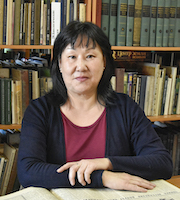On a xylographic compilation of Buddhist texts in Mongolian language from the National Museum of the Republic of Tuva
DOI:
https://doi.org/10.25178/nit.2019.2.12Keywords:
Buddhism; written source; museum; xylographic compilations; Mongolian woodblock print; Mongolian language; Lhantab; Sakya Pandita; Subhashita; lcang skya rol ba'i rdo rjeAbstract
This publication discusses a woodcut compilation of Buddhist texts from the collection of the National Museum of the Republic of Tuva, also providing a transliteration and Russian translation of the text. This woodcut collection in Mongolian (code M–143) is a rather rare edition. It has 11 sheets of small format and consists of short extracts from such works as the “Lhantab”, “The Awakening Sutra of the worship of Yidam (yi dam)”, “Subhashita” by Sakya Panditas, the teachings of Janja-Khutuhta Rolby-Dorje (lcang skya rol ba'i rdo rje) and Yonjin Yeshe Dzhaltsana (yongs 'dzin ye shes rgyal mtshan).
A well-known Mongolian researcher A. G. Sazykin, when describing the Mongolian collection of the Museum, noted the presence of Buryat publications in it. One such sample is a woodcut compilation of the observance of Buddhist vows (M–143), which he had never seen before. The peculiarity of this woodblock is that it adopts a system for placing diacritical marks which differs from that in traditional Mongolian woodblock prints. Thus, diacritical marks in the form of two points, indicating the consonant γ, here indicate the consonant q.
The layout of this collection demonstrates the high erudition of its compiler. Although his name is not explicitly mentioned in the text, there is only an indirect indication that the text was put together by several, rather than one, compilers.
The text allows us to shed some light on the principles of the use of well-known writings in explaining the provisions of the Buddhist doctrine. The fact that the text contains an appeal to believers from among the secular followers of the Buddha’s teaching demonstrates the importance of this field of preaching, practised by Buddhist clergy among Tuvans.
References
Ayusheeva, L. V. (2007) Rol' tibetskogo vrachevaniya v otechestvennoy meditsine (XVII–XX vv.) [The role of Tibetan healing in Russian medicine, 17th-20th centuries] : Thesis of Diss. … Candidate of Medical sciences. Moscow. 24 p. (In Russ.).
Bicheldey, U. P. (2011) Sobranie buddiyskikh rukopisey i ksilografov v fondakh Natsional'nogo muzeya Respubliki Tyva kak pamyatniki dukhovnoy kul'tury tuvinskogo naroda [Buddhist manuscripts and woodcuts in the collections of the National Museum of the Republic of Tuva as monuments of spiritual culture of the Tuvan people]. In: Pamyat' mira: istoriko-dokumental'noe nasledie buddizma [Memory of the world: the historical and documentary heritage of Buddhism]: Proceedings of an international conference / ed. by V. V. Minaev. Moscow, Russian State University for the Humanities. 359 p. Pp. 228–233. (In Russ.).
Bolsokhoeva, N. D. (2009) «Lkhantab» — klyuch k izucheniyu kliniki i terapii tibetskoy meditsiny v manba datsanakh Tsentral'noy Azii ["Lhantab" as the key to the study of the clinic and therapy of Tibetan medicine in manba datsans of Central Asia]. Sinologiya.Ru [online] Available at: http://www.synologia.ru/a/«Lkhantab» (access date: 27.02.2019). (In Russ.).
Vanchikova, Ts. P., Zhabon, Yu. Zh., Rinchinov, O. S., Elepov, B. S. and Shabanov, A. V. (2011) Kollektsiya meditsinskikh tekstov tibetskogo fonda Tsentra vostochnykh rukopisey i ksilografov (TsVRK) Instituta mongolovedeniya, buddologii i tibetologii SO RAN [Medical texts in the Tibetan collection at the Center for Oriental Manuscripts and Woodcuts (TsVRK) of the Institute of Mongolian Studies, Buddhology and Tibetology SB RAS]. Bibliosfera, no. 3, pp. 72–76. (In Russ.).
Dongak, A. S.-O. (2018) Legendy i ustnye rasskazy ob istorii rasprostraneniya buddizma v tuvinskom fol'klore [A history of Buddhism’s dissemination in Tuvan folklore: Legends and oral narratives]. Bulletin of the Kalmyk Institute for Humanities of the Russian Academy of Sciences, vol. 35, issue 1, pp. 113–120. (In Russ.)
Korneev, G. B. (2016) Ob oiratskom staropis'mennom pamyatnike, posvyashchennom traditsii ispolneniia obriada «matsg» [On an Oirat written monument devoted to the tradition of ‘matsg’ ritual performance]. Bulletin of the Kalmyk Institute for Humanities of the Russian Academy of Sciences, vol. 25, issue 3, pp. 201–208. (In Russ.)
Mirzaeva, S. V. (2018) Mongol'skaia rukopis' «Tsaria molitv-ustremlenii o blagom puti» («Bkhadrachar'ia») v Tuvinskom arkhive [The Mongolian manuscript of the «Bhadracarya» (The King of Aspiration Prayers, The Aspiration for Noble Excellent Conduct) from a Tuvan archive]. The New Research of Tuva, no. 4 [online] Available at: https://nit.tuva.asia/nit/article/view/814 (access date: 27.02.2019). DOI: 10.25178/nit.2018.4.11 (In Russ.)
Muzraeva, D. N. (2011) O sostave i soderzhanii kollektsii buddiiskikh pis'mennykh pamyatnikov, sokhranivshikhsya v Kalmykii k nachalu XXI veka [On the composition and content of the collections of Buddhist written monuments preserved in Kalmykia by the beginning of the 21st century]. In: Pamyat' mira: istoriko-dokumental'noe nasledie buddizma [Memory of the world: the historical and documentary heritage of Buddhism]: Proceedings of an international conference. / ed. by V. V. Minaev. Moscow, Russian State University for the Humanities. 359 p. Pp. 233–240. (In Russ.).
Muzraeva, D. N. (2015) Teksty «Subkhashity» na tibetskom i oyratskom yazykakh iz Nauchnogo arkhiva KIGI RAN» [Texts of "Subhashita" in Tibetan and Oirat languages from the Scientific Archive of the Kalmyk Institute for Humanitarian Studies of the RAS]. In: Aziia i Afrika v meniaiushchemsia mire [Asia and Africa in a changing world]. 28th International conference on source studies and historiography of Asian and African countries”, April 22–24, 2015: Abstracts. / ed. by N. N. Dyakov and A.S. Matveev. St. Petersburg, Faculty of Asian and African studies of the St. Petersburg State University. 556 p. P. 247. (In Russ.).
Perevod iz tibetskikh meditsinskikh sochineniy Dzhe-du-ning-nor, gl. 91 i Khlan-tab, gl. 30. Lecheniya chumy, kholery i prokazy. Shtatnogo gelyuna Dambo Ul'yanova [A Translation from Tibetan medical writings, Je-du-ning-nor, ch. 91 and Hlan-tab, ch. 30. Treatments for the plague, cholera and leprosy. By Staff geljun Dumbo Ulyanov] (1902). St. Petersburg, Steam Reprint "Orient" of M M. Gutzats. 25 p. (In Russ.).
Roerich, Yu. N. (1983) Tibetsko–russko–angliyskiy slovar' s sanskritskimi parallelyami [A Tibetan-Russian-English dictionary with Sanskrit parallels]: in 10 issues. Moscow, Nauka. GRVL. Issue I. 378 p. (In Tib., Russ. and Engl.).
Roerich, Yu. N. (1985) Tibetsko–russko–angliyskiy slovar' s sanskritskimi parallelyami [A Tibetan-Russian-English dictionary with Sanskrit parallels]: in 10 issues. Moscow, Nauka. GRVL. Issue IV. 374 p. (In Tib., Russ. and Engl.).
Roerich, Yu. N. (1986a) Tibetsko–russko–angliyskiy slovar' s sanskritskimi parallelyami [A Tibetan-Russian-English dictionary with Sanskrit parallels]: in 10 issues. Moscow, Nauka. GRVL. Issue VI. 372 p. (In Tib., Russ. and Engl.).
Roerich, Yu. N. (1986b) Tibetsko–russko–angliyskiy slovar' s sanskritskimi parallelyami [A Tibetan-Russian-English dictionary with Sanskrit parallels]: in 10 issues. Moscow, Nauka. GRVL. Issue VIII. 311 p. (In Tib., Russ. and Engl.).
Sanchzhey Chzhamtso (1999) Prakticheskoe rukovodstvo po tibetskoy meditsine Lkhan-tkhabs. Razdely ga, nga, cha. Glavy 15–47. Perev. s tib. [A practical guide to Tibetan medicine Lhan-Thabs. Sections ga, nga, cha. Chapters 15–47]. Transl. from Tibetan. Ulan-Ude, Buryat Scientific Center SB RAS. 216 p. (In Russ.).
Uspenskiy, V. L. (2011) Tibetskiy buddizm v Pekine [Tibetan Buddhism in Beijing]. St. Petersburg, NP-Print. 368 p. (In Russ.).
Chzhud-shi. Kanon tibetskoy meditsiny. Perevod s tibetskogo, predislovie, primechaniya, ukazateli D. B. Dashieva [Zhud-shi. The canon of Tibetan medicine] (2001). Translation from Tibetan, preface, notes, indexes by D. B. Dashiev. Moscow, Vost. lit. Publ. 766 p. (In Russ.).
Shantideva. Bodkhichar'ya-avatara (Put' bodkhisattvy) [Shantideva. Bodhicharya-avatara (Path of Bodhisattva)] / transl. by Yu. Zhironkina. Internet-biblioteka buddiyskikh tekstov [online] Available at: http://abhidharma.ru/A/Bodhissatva/Content/Bodhicharya-avatara.pdf (access date: 21.02.2019). (In Russ.).
Das, S. Ch. (1902) A Tibetan-English Dictionary. Calcutta, Bengal Secretariat Press. 1353 p. (In Tib. and Engl.).
Sazykin, A. (1996) The Collection of Mongolian Manuscripts and Xylographs in the Ethnological Museum of the Republic of Tuva in Kyzyl. Manuscripta Orientalia, vol. 2, no. 2, pp. 44–49.
Published
How to Cite
Muzraeva D. N. and Sumba R. P. On a xylographic compilation of Buddhist texts in Mongolian language from the National Museum of the Republic of Tuva. The New Research of Tuva, 2019, no. 2 [online] Available at: https://nit.tuva.asia/nit/article/view/852 (access date: ...). DOI: 10.25178/nit.2019.2.12
Issue
Section

Author(s) license holder(s) grant rights for their work to the journal (grantee of a license) under the simple non-exclusive open license in accordance with Art. 1286.1 «Open license for a research work, work of literature or fine arts», Civil Code of the Russian Federation.
New Research of Tuva publishes articles under the Creative Commons Attribution-NonCommercial license (CC BY-NC).
Since it is an open license, author(s) reserve the right to upload the article to their institutional repository, submit it to another journal (if it allows republications), or republish it on their own website (in full, or in part).
However, several conditions apply here:
a) The republished version must always contain the name(s) and affiliation(s) of the author(s), the original title and the hyperlink to the original version on the New Research of Tuva website;
b) It must be in open access, free of charge, and no category of readers must be in any way whatsoever advantaged over general readership.
c) should the contribution be submitted elsewhere by its author(s) without substantial modification (30% or more of original text unchanged), the body of the article should contain a disclaimer that the original version was published in New Research of Tuva (with a link to the respective page)
The CC-BY-NC is a non-revocable license which applies worldwide and lasts for the duration of the work’s copyright.










